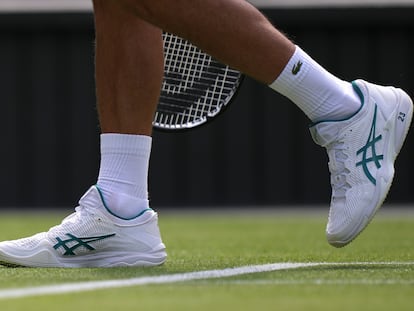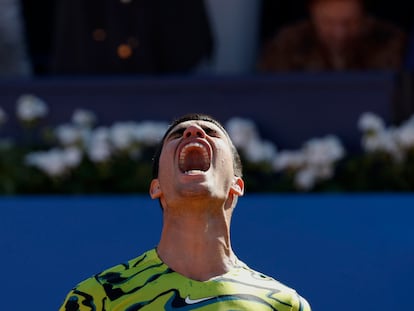Youth on the rise: Tennis consolidates its new era
The Alcaraz-Rune rivalry and the renewed women’s hierarchy symbolize a total transformation in the landscape after two decades of stagnation and the ‘post-Serena’ volatility
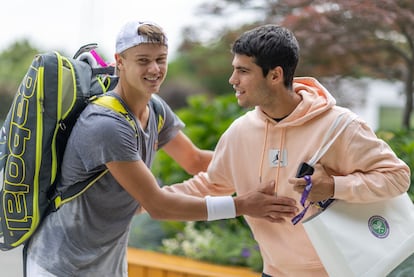

Something was moving, something was happening. And after countless hints, speculations, assumptions, rumors, gossip, and more or less strange and even illogical twists and turns in some cases, it’s here: the new era of tennis is upon us. Its dawn came at this Wimbledon Tennis Championship that has left behind one golden age and opened another that is just as attractive as it is uncertain, but, in any case, is new. The London tournament offers a twofold display in reverse. On the one hand, the men’s circuit has sealed the oligopoly of the last two decades — with the veteran Novak Djokovic an island, as the perennial resistance — while it prepares the stage for new actors, with Carlos Alcaraz in the lead role and Jannik Sinner, Holger Rune and a good handful of aspirants waiting in the wings. On the other hand, the top players in women’s tennis are making a comeback.
“Yes, I think we’re seeing it throughout the year, aren’t we? Swiatek, Sabalenka and Rybakina, who have reached almost every final, are almost always there, and we are also seeing that Jabeur and Pegula are getting stronger. I think everything is stabilizing and in the end, it’s better for the fans because they can hold on to a name and really follow it. I like it,” says former professional tennis player Conchita Martínez, who is happy that the rollercoaster has stopped and that, finally, several players have taken a definitive step forward. Serena left, then Ashleigh Barty and the turbulence that prevailed in their wake is ending. This is corroborated by the events in London, where for the first time since June 2013, all four major seeds have made it to the quarterfinals.
Although she was beaten by Elina Svitolina on Tuesday, 22-year-old Iga Swiatek of Poland rules with an iron fist from the top, with three titles, two finals and two semifinals this year, only missing out in Australia (round of 16) and Rome (quarterfinals), then adding another major to her record (Roland Garros). Her rank is beyond doubt and has significantly increased that of Aryna Sabalenka, who at the age of 25 seems to have found the key to success. The Belarusian won in Adelaide, Melbourne and Madrid, and also frequents the high levels of the tournaments with a growing strength; she has added a couple of finals to the three trophies she has already won. Kazakhstan’s Elena Rybakina (24), the third prong of an increasingly robust trident, is progressing in a similar direction; last season’s Wimbledon champion, this season she is maintaining her good form and has followed up her titles at Indian Wells and Rome with finals in Miami and Australia.
In need of new stimuli and top flight players that engage the general public, as Graf, Hingis, Serena, Arantxa, Serena, Sharapova and company once did, the women’s circuit celebrates the noble struggle between the three and trusts that it will settle down as the post-Serena generation — in its mid-thirties — begins to realize that their share of the cake will probably not be as generous as it was in the last six years. Meanwhile, Sabalenka has the opportunity to interrupt Swiatek’s long reign (68 weeks) and could do so if she can reach Saturday’s final. “To be the best, I need to master all surfaces,” the Belarusian asserts.

The same goes for Carlos Alcaraz, who will meet the Dane Holger Rune on Wednesday. The two are running mates in the youth circuit, and now Rune will be a stumbling block for the Spaniard to reach the semifinal. Both are shining on the grass and are leading an ode to youth: for the first time in the Open Era (from 1968), a men’s quarter-final match brings two players under 21 together in the British major. “As a child, he was already very excitable,” the Spaniard describes his rival at the request of EL PAÍS. “He’s always been a player with a lot of passion, a lot of energy. We have lived together since we were 12 years old. We have grown up together and shared great moments,” the world number one says of his up-and-coming rival. He was beaten by the Scandinavian last year in Paris-Bercy and a year earlier during the Masters Cup, in both cases on the hard court.
Both born in 2003, both 20 years old, they somehow paint an idyllic picture for the trajectory of their sport. With antagonistic personalities, the Spaniard is exemplary and proper, while Rune is becoming known for his friction with his adversaries. “In the end, everyone has their own way,” continues Alcaraz, a debutant in the London quarterfinals. “I don’t know if his growth will be limited by his character; in fact, it might help him. I don’t know if that will be better for one or the other in the future, but everyone has their own behavior. I look out for myself, and I want to behave like that. He was already like that when he was little, very competitive. He always wants to win. Let’s just say he was already... highly strung then,” he continues.
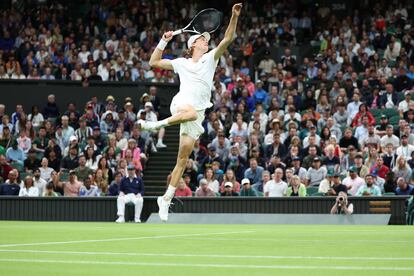
The determination of one contrasts with the very happy-go-lucky image of the other, while Sinner (21) drives a wedge between the two, with a work ethic and a maturity in the game that is also out of the ordinary. The Italian awaits in the penultimate match — for the first time in a Grand Slam — and both the present and the future already look different. After the dreamlike period of confluence between Roger Federer (retired), Rafael Nadal (about to) and Djokovic, the three twenty-somethings have arisen and worked to pick up the baton and dignify it as far as possible, while the batch that tried to break through when the giants had not yet put their racquets away are demoralized. The Medvedevs, Tsitsipas and Zverev are struggling — especially in the case of the latter two — and are trying to make a comeback, but the upstarts are overtaking them on the right.
“It shows that we youngsters are doing very well,” Rune refers to the forthcoming the clash with Alcaraz. “Carlos already had a great forehand in the juniors. He has improved a lot and very quickly,” continues the number six, who turned pro at 16, won a challenger at 18 and last year became the second-youngest player to break into the top-100, only just behind the Spaniard. “I don’t feel better than him. We are both fulfilling our dreams and we are already there,” says the player from El Palmar, while his partner winds down: “We played a doubles once, in Les Petits As [France]. It’s funny, because we were two singles players playing doubles and we wanted to cover the whole court. We did that a little bit, it was fun. The more shots each could hit, the better. I think we made it to the semifinal... And now, we’re going to fight each other at Wimbledon. It’s great.”
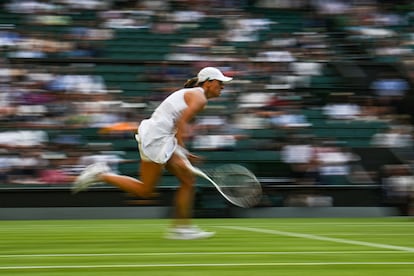
Sign up for our weekly newsletter to get more English-language news coverage from EL PAÍS USA Edition
Tu suscripción se está usando en otro dispositivo
¿Quieres añadir otro usuario a tu suscripción?
Si continúas leyendo en este dispositivo, no se podrá leer en el otro.
FlechaTu suscripción se está usando en otro dispositivo y solo puedes acceder a EL PAÍS desde un dispositivo a la vez.
Si quieres compartir tu cuenta, cambia tu suscripción a la modalidad Premium, así podrás añadir otro usuario. Cada uno accederá con su propia cuenta de email, lo que os permitirá personalizar vuestra experiencia en EL PAÍS.
¿Tienes una suscripción de empresa? Accede aquí para contratar más cuentas.
En el caso de no saber quién está usando tu cuenta, te recomendamos cambiar tu contraseña aquí.
Si decides continuar compartiendo tu cuenta, este mensaje se mostrará en tu dispositivo y en el de la otra persona que está usando tu cuenta de forma indefinida, afectando a tu experiencia de lectura. Puedes consultar aquí los términos y condiciones de la suscripción digital.
More information
Archived In
Últimas noticias
Luisa Neubauer, climate change activist: ‘Ecology shouldn’t be a punitive force, but a joyful and liberating one’
Trump followed CIA recommendation to hand power to Delcy Rodríguez due to risk that Machado would not control the army
The Motherwell painting that Franco wanted to hide from view
Mexico seeks to shore up its defenses following US incursion in Venezuela
Most viewed
- Alain Aspect, Nobel laureate in physics: ‘Einstein was so smart that he would have had to recognize quantum entanglement’
- Alvin Hellerstein, a 92-year-old judge appointed by Bill Clinton, to preside over Maduro’s trial in New York
- Cuba confirms death of 32 of its citizens in the US attack against Venezuela
- Gilles Lipovetsky: ‘If you want to live better and fall in love, take Prozac, don’t look to philosophy’
- Why oil has been at the center of Venezuela-US conflicts for decades
